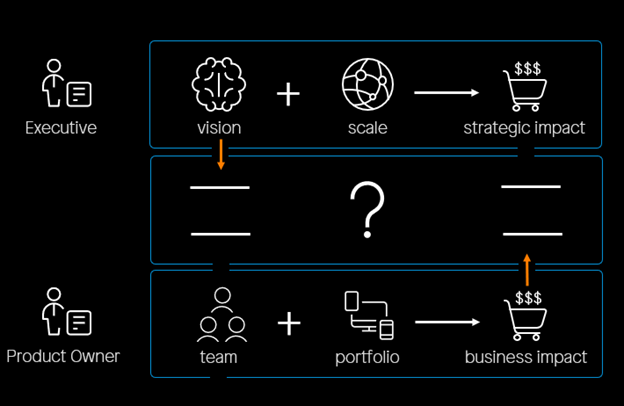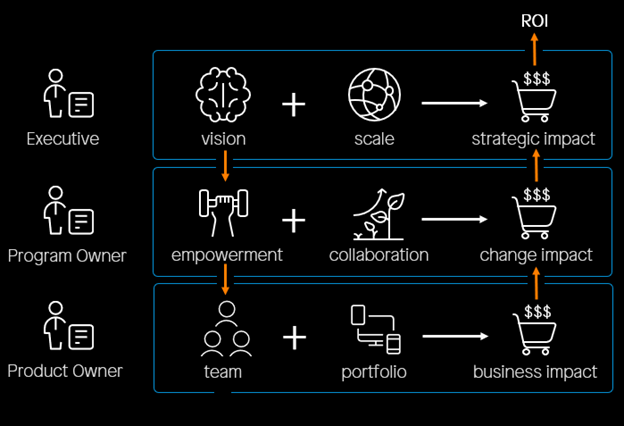Overcome the Challenges of Digital Transformation with Vision Setting

Only three out of ten digital transformation initiatives succeed, according to separate research by McKinsey & Company and Boston Consulting Group. When looking for the success factors of that 30%, we find an interesting conclusion: there is no real pattern in the “what” – the paths to value vary per industry when you consider “what” to focus on. The repeatable success factors lie in the “how.”
Organizations need a guide to help them successfully navigate the “how” in the path to their digital transformation. This is why Mendix established the Digital Execution Practice: to provide this guidance.
One of the biggest challenges we see organizations dealing with in their digital transformation path is a lack of communication, alignment, and execution from all levels of the business.
The best tool to counteract these challenges is a vision. Because of that, it’s crucial to understand how to create a vision, know what goes into that vision, and how to set it (and reset it).
Why do companies fail at digital transformation?
Imagine that a group of people are told to travel to Japan. Each person in that group plans differently, is given a different set of directions, and packs their bags differently. One person arrives in Hokkaido in two weeks. Another arrives in Tokyo three months later. One person doesn’t manage to get there at all. And 12 months later, someone arrives in Narita but remains stuck in the airport. The destination was unclear (Japan is a big place, after all), and every traveler was left to their own devices on how and when to get there. The group’s trip was not successful.
Digital transformation plans can be the same. Organizations stumble on the path to digital transformation when there’s a wide gap between strategy and execution. If you’re looking down at the gap between these layers, know that it’s not just you. Harvard Business Review suggests that only 8% of executives are good at strategy and execution.
At the strategic layer, you and other executive types should set the initiative’s vision. You decide the direction of the company (new markets to enter, new channels to open) and determine the balance between modernizing current systems and processes and creating new technologies.
Then there’s the product or project layer. From an IT perspective, this would be a group of developers, testers, UX and product designers, business analysts—to name a few—who collaborate to create a portfolio of applications. These applications drive business value (i.e., create revenue, save on costs, increase customer engagement, etc.). They should also support the larger digital transformation initiative.
In between these layers are gaps where the vision can get lost in translation. What happens is that the executives at the top often set the vision, and then communicate to department heads, who are then saddled with figuring out the strategy and how their teams are going to execute.
Every department has its own set of resources, skills, and needs. Strategies that each department sets will be different, and the execution of that strategy will vary wildly. If those executing the strategy are getting different interpretations of the vision, results and output are going to differ from department to department. They could be executing in the wrong way or producing the wrong things. Giving orders from on high and then shutting your office door may work for some executives, but for the rest of us, it’s not a great strategy in the real world

Gain Clarity with Your Digital Transformation Strategy
Getting to your digital transformation destination is a lot easier when a vision is clear and clearly communicated up and down the organization.
It’s up to you to set up a layer between executives and executors. In this layer, change process is managed by a group you’ve hired/enabled to carry forth your vision across all departments. To extend that travel metaphor, you need to hire a team of people to ensure that, no matter the mode of transportation that everyone arrives at the same destination around the same time.
This means hiring a program owner or manager(s) to empower each collaboration across departments. The program owner will collaborate with the executive to define and run the Program, providing guidance on how to translate the vision into an executable strategy. Often, it’s advantageous for the program owner to be deeply involved in defining the vision itself due to their active role and responsibility in its delivery. Once the program has been set up, the program owner ensures that the application portfolios being developed meet the criteria and support the digital transformation strategy across all departments.
The impact made at this level is huge. This is where you can foster change management and get everyone on board and comfortable with a new way of working.

What Goes into Your Digital Transformation Strategy?
Now that we’ve talked about what to put into place so your strategy is communicated well, we can talk about what your vision should be. Once more with the travel metaphor: If folks don’t understand the goals of the trip, they’re less likely to arrive in the same place at the same time.
Digital transformation can appear to be a huge challenge because there’s just so much to work through and tackle. How do you balance the look toward the future with tech or processes from the past? What’s the perfect balance between doubling down on what works and optimizing it versus entering an entirely new market or activating an unused channel?
While there’s no magical digital transformation ratio, getting the base right is critical for success. That means addressing technical debt with the objective of making it easier to compete and build value. Unaddressed technical debt creates a huge drag on any business transformation effort. According to McKinsey research, technical debt amounts to 20 to 40 percent of the value of their entire technology estate.
It’s like trying to climb a mountain while carrying a backpack that keeps getting heavier. You need to cut that weight and climb the mountain one step at a time. So, in addition to cutting technical debt, it’s a matter of looking inward at your business, seeing what the needs are, getting the right balance, and then declaring your ambition or vision.
Optimization
Part of your vision could be looking at what you currently do well and improving it. Look toward processes that could be improved, different ways of optimizing revenue streams. You could look at technologies and automation that help improve productivity (and thus reduce costs). Perhaps there are ways to improve your customer experience—these could also lead to more transformational initiatives as well—that could thus improve retention rate.
Transformation
Are there new markets or industry segments you feel your company is ready to disrupt? For this part of your strategy you’ll want to mark down any net-new digital products or services that could allow you to reach those new audiences.
Or maybe your product remains the same, but you have new business models set up around that (subscription or platform-based models come to mind here).
What’s Affected?
Knowing what you want to do isn’t enough for your vision. You need to know what it affects or is affected by. Look at the technological, cultural, and any industry-specific variables that will specifically be altered by your vision.
Considering all of these aspects will help you create a well-balanced strategy that will give you a metered approach to digital transformation.
Destination UnKnown
Knowing where you want to go is one thing. Telling others how to get there is another. Putting the pieces into place so that your vision is clear, accepted, and uniformly executed is crucial to any strategy, especially with an undertaking of such enormity as digital transformation. Digital transformation is endless. But the goals you set can be attainable. Once you achieve them, and your business has evolved, you’ll see that the journey starts again and you need to reset your goals and ask what’s next. And when you answer that question, make sure everyone else knows, too.